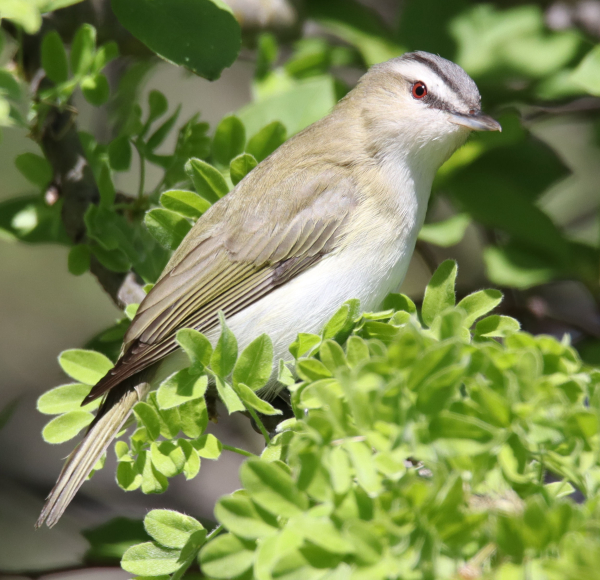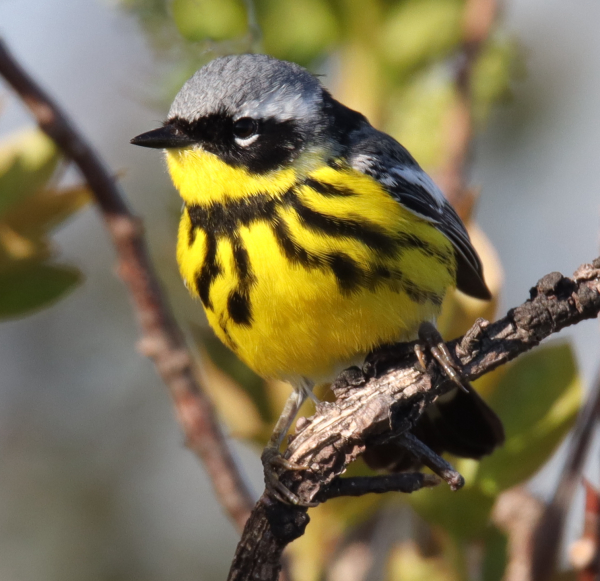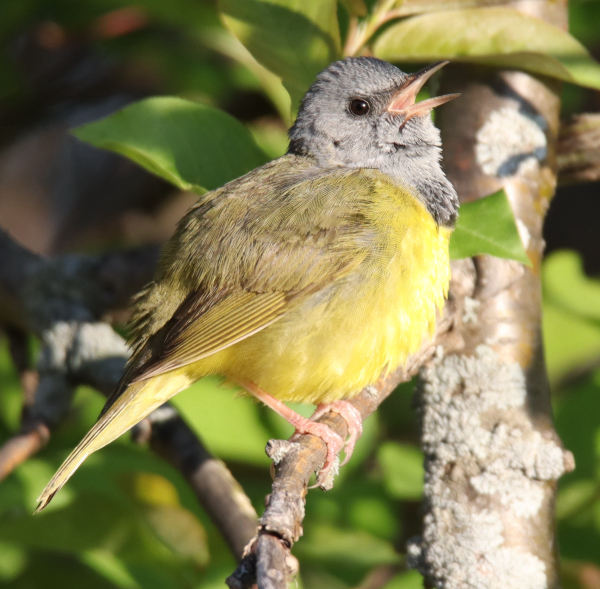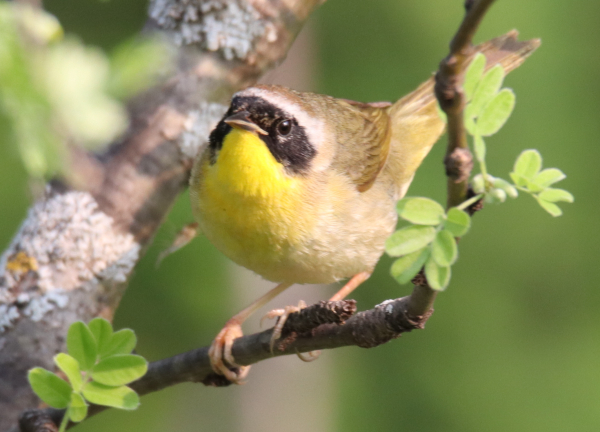
A standout photo opportunity for the week provided this image of a Red-eyed Vireo, which was one of many migrating songbirds that stopped over at Melody’s Grove.

A surprise encounter with a male Magnolia Warbler provided interesting observations and photographs.

For a couple minutes, a Mourning Warbler was uncharacteristically vocal, singing often from a number of perches.

One moment there is no sign of any birds, the next a Common Yellowthroat pops into view, eventually providing a nice photo op. What new birds will appear in the coming week?
|
Although there were daily mini-fallouts of songbirds and flycatchers each morning beginning Monday last week, Friday marked the first true fallout at Melody’s Grove, punctuated by many Blackpoll Warblers, Yellow Warblers, and Least Flycatchers, including the first female Blackpolls and the first female Yellow Warblers aside from a single female earlier in the week. Other species included a couple Mourning Warbler sightings, which have continued through the week, a female Black-and-White Warbler, and a few female Yellow-rumped Warblers, along with Ruby-crowned Kinglets, Swainson’s Thrushes, and a couple Chipping Sparrows.
I kind of expected to see a representative of the third group of warblers that passes through the area last – a Magnolia or a Wilson’s perhaps, but soon there will be more – maybe tomorrow, because there seem to be daily surprises at The Grove. Friday’s influx of songbirds and flycatchers was quite a surprise considering there was a howling north wind, but that might have concentrated the birds in the little green corner where I’ve been concentrating my photo efforts at most of the week. With the bulk of the trees positioned to the north and west, that interior corner kept the wind at bay, so insects were more active there, perhaps more plentiful too; plus that east side catches the morning sun, and it has the earliest and prettiest green vegetation to act as perches and backdrops for photos.
About 4 hours after writing the above paragraph, I broke away from my office and checked out my other 2 migration fallout locations, in spite of the exceptionally strong north wind. The farmhouse hotspot, which I expected would be the best bet, held not a songbird, again; so I almost didn’t check the lake hotspot. But along the way I observed a few of the first Bobolinks of the year, so I kept going. When I arrived at the tall spruce trees, a Palm Warbler caught my attention, along with male and female Blackpoll Warblers, and a few Yellow Warblers. When I continued a couple hundred feet to the chokecherry and wild plum grove, it was filled with the latter 2 species.
I photographed a while, and again the thought of species yet to come entered my mind – and then it happened. A Wilson’s Warbler made its way into view – nice; plus a Magnolia Warbler showed 50 feet away. Would they avail themselves for photos? I would sure appreciate photos of both, especially the Magnolia, which is clearly one of my favorites – what impressively colored birds they are! After a few photo ops presented by the Wilson’s, I viewed the Magnolia with binoculars as it foraged ever-closer, which showed it was a fully colored male.
It stayed at a distance, mostly in the shadows, showing little promise of photo ops, so I repositioned a couple times without luck. But suddenly it changed its keep-away game and started moving in my direction, slipping into the sunlight – and for a few moments it was providing some quality views in fairly open locations that yielded really nice photos. I can only expect that tomorrow (Saturday) will be an even better warbler day.
Tranquil Weekend
After expecting little during north wind Friday but getting an impressive fallout of songbirds, I really thought Saturday might bring the best birds of the week, what with a still wind until early morning and a south wind thereafter. But while very few new birds arrived at Melody’s Grove, most of the birds from Friday left – there were no Blackpoll Warblers, only a few Yellow Warblers, no Swainson’s Thrushes, and a few Ruby-crowned Kinglets – it was quite a change.
The one new species was a pair of male American Redstarts, which certainly could have held my attention, but only one availed itself for a few photos while mostly staying in the shadows. The second redstart never fully showed itself from behind the veil of new leaves. But the highlight of the morning was the chance to photograph 3 species singing – a Mourning Warbler, a Yellow Warbler, and the first American Redstart. There was also the added action of a pair of Wood Ducks investigating cavities in the tall cottonwoods and taking circling flights overhead regularly.
Sunday was really slow at The Grove, and I almost cut my morning short, but that’s when a Common Yellowthroat, the first male of the season, popped into view and as it moved from low tree branches to the almost-flowering bush that I like to photograph birds at, it stopped in an excellent position. Although Common Yellowthroats aren’t rare, as their name implies, I’ve found that it sure is hard to get photos of males. They are usually moving out of sight, singing regularly but skulking low in cover, popping into view for a second before hiding again; but this yellowthroat provided a couple breakthrough photos during a rare seconds-long hesitation in the open before me.
A couple Tennessee Warblers broke up the morning along with a couple Yellow Warblers, a male Blackpoll Warbler, a Ruby-throated Hummingbird, along with an initial male Baltimore Oriole. Sunday, instead of Wood Ducks investigating cavities in the tall cottonwood trees it was a pair of Hooded Mergansers. It’s also worth noting that Sunday was the first morning in the week that I didn’t see a Mourning Warbler.
More Mournings
Earlier in the week, after observing and photographing a relatively rare Mourning Warbler a couple times Tuesday, which I described and illustrated in last week’s Bird Photography feature, I spent a couple hours in the company of a Mourning Warbler on Wednesday mourning too. Judging from its behavior, it was not the same bird that I photographed Tuesday, although Wednesday’s male looked very similar.
Rather than being the fast-moving far-ranging individual I photographed the previous morning, Wednesday’s Mourning Warbler stayed in a very compact area, seemed to rest and preen for a time, usually in a tangle of vegetation near ground level. Then periodically the warbler popped out of the low vegetation to make regular forays across an area that measured about 50 feet long, 25 feet wide, and from ground level to 12 feet high. During a period of about 100 minutes, the Mourning Warbler made 12 feeding forays within the above area – fast but productive movements from branch to branch, grabbing insects along the way.
After most feeding episodes, the warbler would dive into a tangle of bushes near the ground for several minutes, then reappear and conduct another fast-paced and productive search for insects. One time though, the warbler perched in the open during its “down time.” It rested a bit, but mostly preened, then hopped to an open sunny perch where it stretched into a fairly horizonal “sunning” position, even closing its eyes with its mouth open at times. I always find that when birds repose in a sunning or anting position, they almost seem to go into a trans-like state for a bit; it’s a bit weird-looking frankly. Anyway, it was interesting to monitor this Mourning Warbler’s behavior for an extended period, and to photograph it when possible throughout the morning minutes.
The Mourning Warbler’s lair was coincidentally my favorite place to stop along the eastern edge of Melody’s Grove, and other species on hand included Yellow Warblers, Ruby-crowned Kinglets, a couple male Baltimore Orioles, Chipping Sparrows, and Least Flycatchers. The regular birds found at The Grove these days include Gray Catbirds, House Wrens, Eastern Kingbirds, and American Robins.
Mini-Thursday
Thursday morning revealed a nice mini-fallout at Melody’s Grove, with a beautiful male Blackpoll Warbler being the first to catch my attention. There were several Blackpolls, along with Tennessee Warblers, a female Black-and-White Warbler, an Orange-crowned Warbler, a few female and yearling Yellow-rumped Warblers, and many Yellow Warblers, along with 2 different Mourning Warblers. Equally exciting were a few Red-eyed Vireos and Warbling Vireos, with a Red-eye providing some nice portrait photos. A few Swainson’s Thrushes were also evident after not seeing thrushes for several days, and the 4 species of sparrows present included Clay-colored, Lincoln’s, White-crowned, and Chipping Sparrows – collectively creating quite an active morning.
Back home, after the previous Monday’s surprising number of Orchard Orioles, by Thursday no female Orchard Orioles graced my feeding station (which continued until Sunday), but at least 3 males were active. In comparison, there were ample numbers of Baltimore Orioles, maybe 9 or more overall, with more males than females. While it’s great to report the white-winged male Baltimore Oriole remains, it looks even more promising that he may be a spring and summer resident.
Although the white-wing makes regular visits to the jelly feeders, during 2 of his visits Thursday he arrived with a female! Plus, both times he appeared to display toward her, cocking his tail and pointing his bill upward while hopping from perch to perch to perch and back again just above the feeders – how exciting is that!
Also Thursday, a hummingbird zipped by, literally. It flew quickly directly at the oriole feeder, but before reaching the feeding station it vanished without stopping, hovering, or investigating the nectar feeder – interesting.
Weekend Orioles
Saturday’s regular feeder visitors included a yearling male Orchard Oriole, but there were still no females to be seen since Tuesday. Sunday at least 3 yearling Orchard Orioles were present by the end of the afternoon, along with 2 or 3 female Orchard Orioles that mixed in with at least 3 adult males. I also caught sight of a brief stop at my nectar feeder by a Ruby-throated Hummingbird. Yard birds included a male Yellow Warbler and a Swainson’s Thrush.
One point of concern was that I didn’t see the white-winged Baltimore Oriole among the many Baltimores that fed on grape jelly, although my observations were somewhat limited Sunday; hopefully the white-wing will show Monday (and he did; once Monday afternoon and with greater frequency through the evening, although it was uncharacteristically quiet without the usual calling and singing – hmm).
Post-Weekend
Monday morning at Melody’s Grove was a bust; didn’t take a photo, although there were new orioles to be seen, male Baltimores and yearling male and female Orchard Orioles, but the only warbler aside from a few male Yellow Warblers was a male Common Yellowthroat – but none offered a photo opportunity. That’s the way it goes during spring songbird migration, some days are like Monday, some are like last Wednesday, and it’s really exciting when mornings like Friday explode The Grove with warblers, other songbirds, and flycatchers. As for my other locations, there were a few Yellow Warblers present at The Lake hotspot, along with an adult male Orchard Oriole.
There will be more days like Friday, and it will take an inquisitive look each morning to see what has transpired overnight and during early morning. Now I’m willing to admit that there is no way to predict migration stopover action. Even when there are huge songbird migrations happening, it doesn’t mean a single bird will stop at a given location – they may all just fly overhead, perhaps a thousand feet high, or a few hundred feet high, but none may stop. But some mornings some songbirds will have stopped over to recharge their tiny bodies physiologically, gorge on insects, and rest, and that’s when it gets especially exciting.
Wednesday morning may offer a really good fallout, with a bit of rain expected late Tuesday, which can short-stop birds that may utilize the south wind – but then again, I’m ending all predictions. I’ll just show up in the morning with my camera and hope for the best during the next week. Enjoy the songbirds that surround you at home and in the field.
Article and photos by Paul Konrad
Share your bird sightings and photographs at editorstbw2@gmail.com